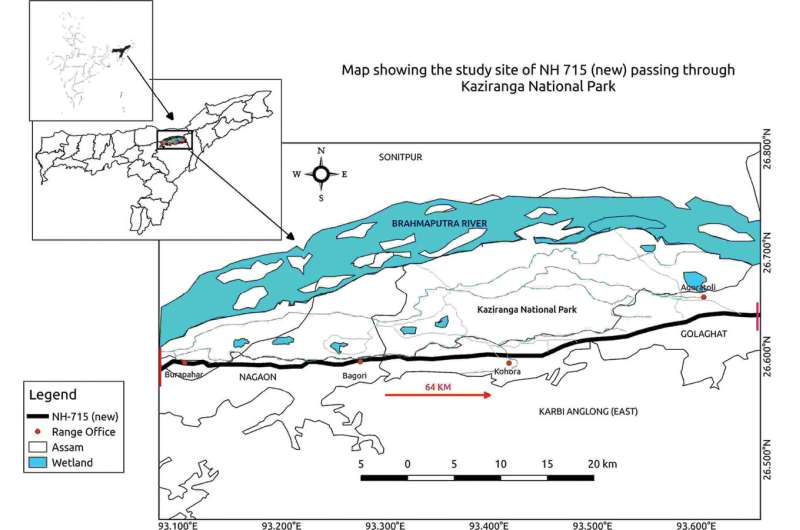Major highway in India studied for its danger to reptiles and amphibians

"Is it the road that crosses the habitat, or does the habitat cross the road?" ask scientists at Gauhati University (Assam, India) before agreeing that the wrong road at the wrong place is bound to cause various perils for the local wildlife, habitats and ecosystems. Furthermore, some of those effects may take longer than others to identify and confirm.
This is how the research team of doctoral research fellow Somoyita Sur, Dr. Prasanta Kumar Saikia and Dr. Malabika Kakati Saikia decided to study roadkill along a 64-kilometer-long stretch of one of the major highways in India: the National Highway 715.
What makes the location a particularly intriguing choice is that it is where the highway passes between the Kaziranga National Park, a UNESCO World Heritage site in Assam and the North Karbi Anglong Wildlife Sanctuary, thus tempting animals to move to and from the floodplains of Kaziranga and the hilly terrain of the Sanctuary to escape the annual floods or—on a daily basis—in search for food and mating partners.
In the beginning, they looked into various groups, including mammals, birds, reptiles, and amphibians, before realizing that the death toll amongst frogs, toads, snakes and lizards was indeed tremendous, yet overlooked. Their findings were recently published in the peer-reviewed scholarly journal Nature Conservation.
"To our surprise, the death toll within that 64-kilometer stretch of the highway was indeed dramatic. We estimated that it has been over 6000 animals that have fallen under the wheels of motor vehicles within a single year. Prior to our study, similar research had focused on big charismatic species like the tiger, elephant and rhino, so when we took into account also the smaller animals: frogs, toads, snakes and lizards, the count went through the roof. Thus, we decided to make smaller species the focus of our work," comments Sur.
In conclusion, the scientists agree that roads and highways cannot be abandoned or prevented from construction and expansion, as they are crucial in connecting people and transporting goods and necessities.
"Yet, we can definitely put some effort into designing and constructing them in a scientifically sound, eco-friendly and sustainable manner, so that they don't become the bane for our ecosystems," the team concludes.
More information: Somoyita Sur et al, Speed thrills but kills: A case study on seasonal variation in roadkill mortality on National highway 715 (new) in Kaziranga-Karbi Anglong Landscape, Assam, India, Nature Conservation (2022). DOI: 10.3897/natureconservation.47.73036
Journal information: Nature Conservation
Provided by Pensoft Publishers





















